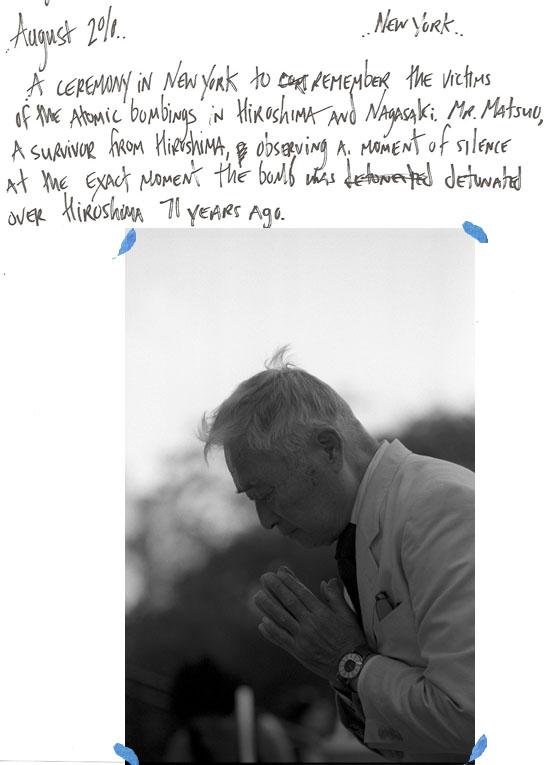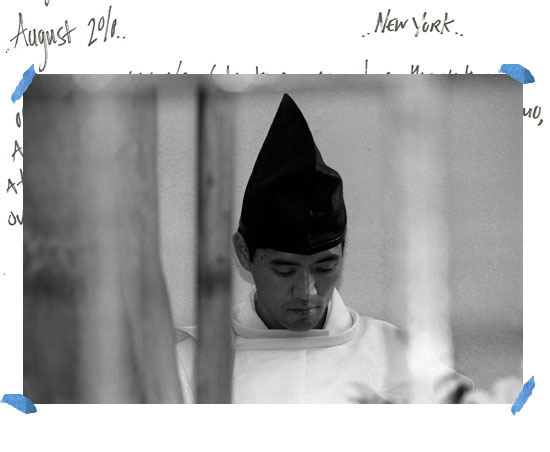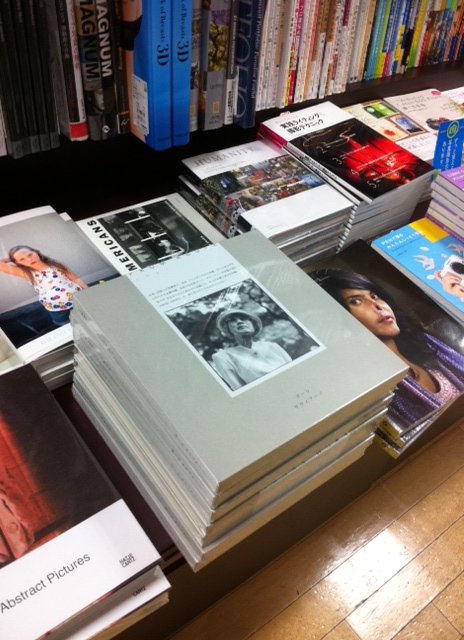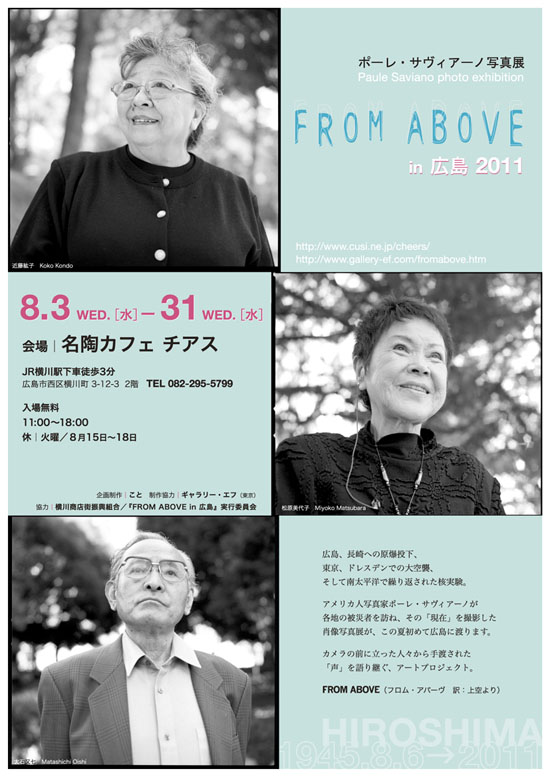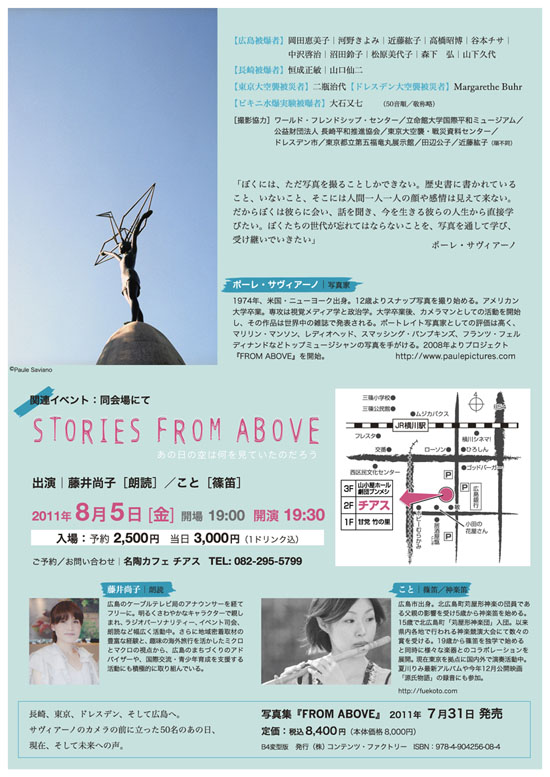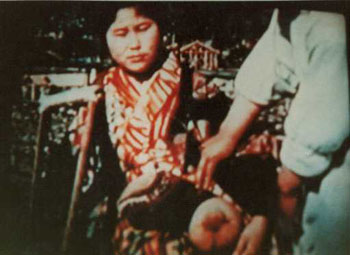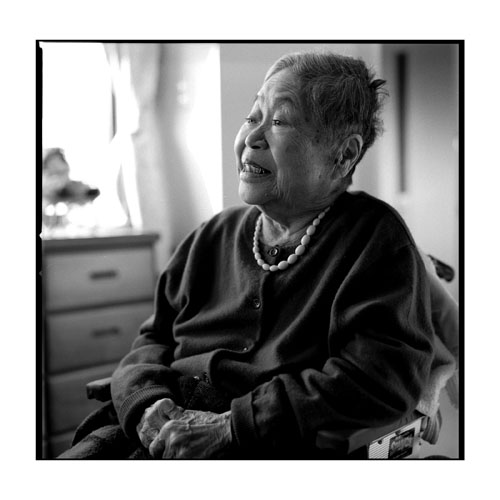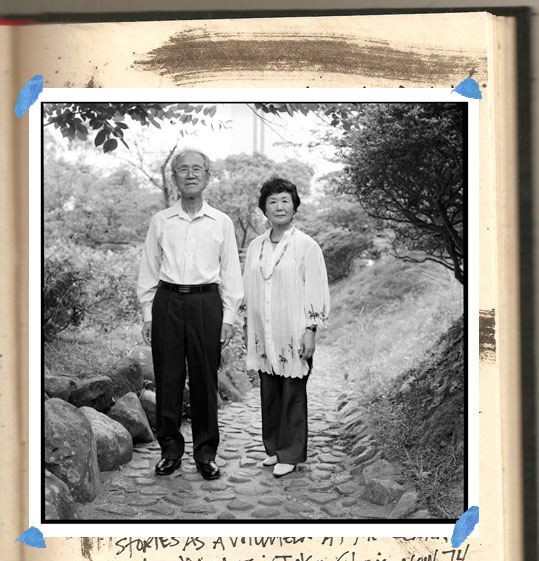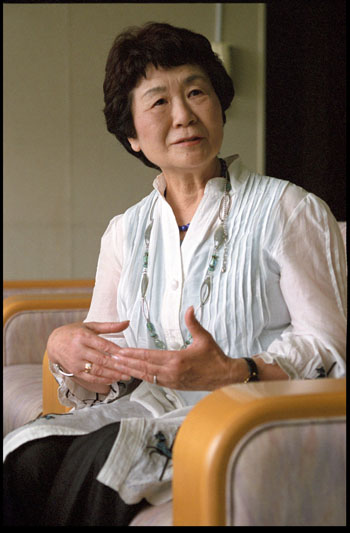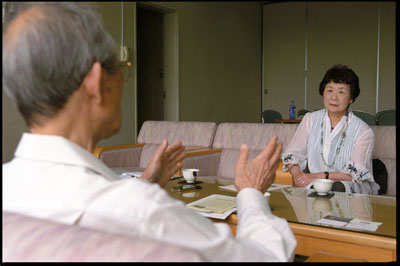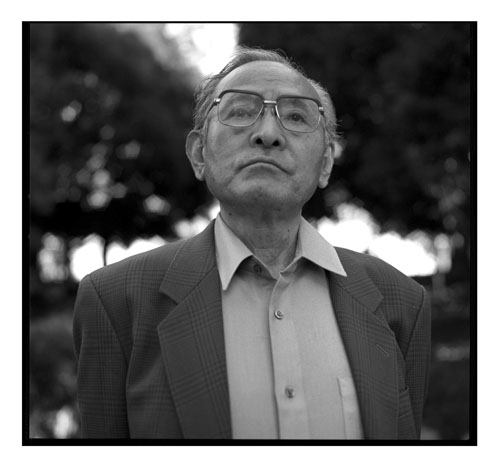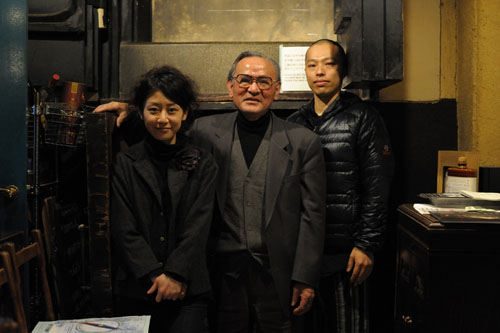Archive for the ‘Hibakusha’ Category
Hiroshima
Sunday, August 7th, 2011Installation of From Above photography exhibtion in Hiroshima
Wednesday, August 3rd, 2011Commericial for From Above photography exhibition in Hiroshima
Wednesday, August 3rd, 2011..July 2010.. ..Hiroshima..
A commercial for the From Above photography exhibition in Hiroshima, Japan.
The book, From Above, will be available at the venue. It will be officially released in Japan next week and throughout the US and Europe soon after. I’ll be sending out information on the book release as soon the book is available in the stores and on-line.
From Above
Photography Exhibition in Hiroshima
By Paule Saviano
Venue
Cafe Cheers
2F, 3-12-3 Yokogawa-cho, Nishi-ku, Hiroshima-city
(3 minutes walk from JR Yokogawa station)
TEL 082-295-5799
http://www.cusi.ne.jp/cheers/
August 3rd – 31st 2011
Open: 11:00-18:00
closed on Tuesdays & 15-18 August
entrance free
Related events:
“STORIES FROM ABOVE”
FRI. 5 August
OPEN 19:00 START 19:30
admission: Adv. 2,500 Yen/ Door 3.000 Yen with 1 drink
Koto (Shunobue flute), Shoko Fujii (reading)
From Above in Tokyo book stores
Monday, August 1st, 2011..July 2011.. ..Tokyo..
FROM ABOVE at Kinokinuya book store during the first weekend of it’s release in Tokyo. A great compliment to be placed on the same shelf as Robert Frank’s The Americans (top).
FROM ABOVE is now available at Kinokinuya stores and on-line throughout Japan or directly from the publisher Contents Factory.
It will be available in the US and Europe shortly (hopefully within the next 7-10 days in the US) at Kinokinuya stores (retail and on-line) and through Amazon.com.
From Above Photography Exhibition in Hiroshima
Friday, July 29th, 2011..July 2010.. ..Hiroshima..
A commercial for the From Above photography exhibition in Hiroshima, Japan.
The book, From Above, will be available at the venue. It will be officially released in Japan next week and throughout the US and Europe soon after. I’ll be sending out information on the book release as soon the book is available in the stores and on-line.
From Above
Photography Exhibition in Hiroshima
By Paule Saviano
Venue
Cafe Cheers
2F, 3-12-3 Yokogawa-cho, Nishi-ku, Hiroshima-city
(3 minutes walk from JR Yokogawa station)
TEL 082-295-5799
http://www.cusi.ne.jp/cheers/
August 3rd – 31st 2011
Open: 11:00-18:00
closed on Tuesdays & 15-18 August
entrance free
Related events:
“STORIES FROM ABOVE”
FRI. 5 August
OPEN 19:00 START 19:30
admission: Adv. 2,500 Yen/ Door 3.000 Yen with 1 drink
Koto (Shunobue flute), Shoko Fujii (reading)
From Above Photo Exhibition in Hiroshima
Friday, July 22nd, 2011These are the posters for the upcoming From Above photo exhibition in Hiroshima from August 3rd-31st.
This will be the 5th exhibition of the on-going portrait series about Hibakusha, atomic bomb survivors. This series in Hiroshima has not been shown before.
The book, From Above, will be released in Japan next week and is available at the venue. It will also be released in the US and Europe shortly after. I’m hoping it will be delivered to the stores in the US by the first week of August. More information will be posted next week on where it’s available on-line and in stores.
The exhibition will move to the Kyoto Peace Museum during September. The prints shown in Kyoto will be different than in Hiroshima. I will post information about the Kyoto exhibition in a couple of weeks.
Mrs. Suzuko Numata
Thursday, July 14th, 2011..July 2011.. ..Hiroshima..
I received the sad news Mrs. Suzuko Numata passed away on July 12th, 2011, at age of 87.
She was an atomic bomb survivor, an Hibakuska, I photographed during November 2010. I spent many hours with her at the elderly home listening to her story. She was one of the kindest people I’ve ever stumbled upon.
There is a famous photo of her taken soon after the atomic bombing showing her amputated leg. But, I hope the portrait I took of her months before her passing demonstrate how warm and caring a person she was.
She passed away three weeks before the release of From Above, the book that will include her portrait. I’m sorry she will not be here to see her portrait. I consider myself lucky to be able to share her stories through the portrait and words in the book.
Mrs. Numata is the 5th person to pass away since I began photographing the project 3 years ago.
Mrs. Chisa Tanimoto
Wednesday, June 1st, 2011Today I received the sad news that Mrs. Chisa Tanimoto passed away on May 4th, 2011 at the age of 95. I photographed Mrs. Tanimoto in Hiroshima during November 2010. She is the third hibakusha, atomic bomb survivor, I’ve photographed to have passed away in the last 4 months and fourth to have passed since the start of the project.
We were introduced by her daughter Koko Tanimoto-Kondo. They are the first parent and child hibakusha I have photographed.
I didn’t spend much time with Mrs. Tanimoto because of her fragile health. But those few moments we spent together were memorable.
Mrs. Tanimoto was the wife of the well-known minister Kiyoshi Tanimoto, famous for his work with the Hiroshima Maidens and support for war orphans. Mrs. Tanimoto life was also equally as devoted to seeking peace. The family has worked constantly helping provide homes for war orphans and relief to hibakusha.
It was an honor to have met Mrs. Chisa Tanimoto.
Her portrait will be a part of the upcoming book, From Above, released on July 27th by publisher Contents Factory. Her portrait will also be shown in the upcoming exhibition at the Kyoto Peace Museum during September 2011.
Hibakusha, atomic bomb Survivor, Mr. Masatoshi Tsunenari and Tokyo fire bombing Survivor Ms. Haruyo Nihei
Tuesday, March 8th, 2011..June 2010..
Hibakusha, atomic bomb Survivor, Mr. Masatoshi Tsunenari and Tokyo fire bombing Survivor Ms. Haruyo Nihei a block away from the epicenter where the atomic bomb was detonated in Nagasaki.
Ms. Haruyo Nihei, a Tokyo fire bombing Survivor I photographed for the original From Above series, accompanied the exhibition when it was shown at the Nagasaki Peace Museum during June/July 2010. She wanted to tell her story of surviving the 3/10 fire bombing of Tokyo to an atomic bomb Survivor.
Hibakusha Mr. Tsunenari agreed meet Ms. Nihei in Nagasaki. It was an amazing moment to see them listen and exchange stories. Tragic moments in time that changed their lives instantly.
It was the highlight of my trip to Nagasaki. I was proud the exhibition was shown at the Nagasaki Peace Museum. But to see the feelings of Ms. Nihei, it’s what I want From Above to be about. A project that eclipses my photos and allows others to reach out to one another. Seeing Mr. Tsunenari listen to and accept Ms. Nihei’s story of the 3/10 Tokyo fire bombings was moving. I believe it was a great feeling of relief to Ms. Nihei to be able to share her story.
Many of the 3/10 Survivors don’t get the recognition as others. The event is swept away as a side note in the history books and society. On March 10, 1945 more people died in Tokyo, during one night, than in both atomic bombings combined.
Mr. Matashichi Oishi, former crew member of Lucky Dragon 5, Bikini Atoll Hibakusha
Thursday, March 3rd, 2011March 1, 1954….
Matashichi Oishi
Born 1934 in Shizuoka, Japan
Mr. Matashichi Oishi is a former crew member of the Daigo Fukuryu-Maru (Lucky Dragon 5), tuna fishing boat. He turned 20 years old on the second day of the journey from Yaizu harbor to Marshall Islands. Due to the postwar food shortages, they had to sail farther distances to catch fish. The boat trip from central Japan to the Marshall Islands took over 2 weeks, one way.
There were 23 crew members on the wooden boat. Average age was 25 years old. In the early morning of March 1st, 1954, the boat was exposed to radiation by a hydrogen bomb nuclear test at the Bikini Atoll. It was an unannounced secret test. They were fishing 160km away from the hypocenter.
The bomb was 1,000 times more powerful than the atomic bomb detonated in Hiroshima. It contained 270 different kinds of radioactive materials.
Mr. Oishi saw a strong flash of light. An orange color soaked the sky. After 7 minutes they heard horrific rumbling. Strangely, the sea surface stayed calm. They were frightened and decided to return.
They had to raise the fishing nets and long fishing lines from the deep water. This took hours to complete. Soon after “ashes of death”(nuclear fallout) started falling, covering the boat like snow. They had no idea what it was, some licked the flakes. The flakes of ash didn’t melt, felt like sand, and burned their skin.
They removed the fishing nets and long fishing lines while the radioactive ashes fell. It took 5 hours to get the equipment to the surface so they could begin their voyage home.
After a 2 week journey, they arrive at Yaizu harbor. All of them already suffered from acute radiation diseases such as dizziness, loss of appetite, gum bleeding, diarrhea, vomiting, and hair loss. But they still didn’t know what they were exposed to.
A newspaper released the news about the nuclear test. It caused a panic in Japan. “Poisoned fishermen brought back poisoned tuna.” Even rain contaminated with radioactivity feel over Japan and other countries in the Pacific Ocean.
The panic created an anti-nuclear movement and encouraged Hiroshima and Nagasaki atomic bomb Survivors to speak about their experiences. Nearly 10 years after the bombings in Hiroshima and Nagasaki, this was the first public discussion about nuclear weapons in Japan.
During the American Occupation after WW II, news about the atomic bombings in Hiroshima and Nagasaki was censored. The American government allowed no public discussion or articles in Japan to be written about the bombings. The official reason given, as a precaution of the Cold War they didn’t want the USSR to gain information about the affects or material used. Because of the censorship the Japanese public, outside of Hiroshima and Nagasaki, were largely unaware about the affects of radioactivity.
The Lucky Dragon 5 event was covered up in negotiations between the US and Japanese governments. The boat was painted over and dumped in a landfill in Tokyo. The ill fishermen were abandoned and outcast socially. Their lives changed completely. They didn’t have visible burn or scar but inside their bodies were radioactively contaminated. All battled various types of cancers throughout their lives. The first member of the crew died a half year later. More than half of the crew has died. All of them died from liver cancer.
Mr. Oishi has also suffered for varied aftereffects; including liver cancer and social discrimination. The company and government have claimed no responsibility for his health care bills even though he was exposed while working.
After 30 years of silence, he started to speak about his experiences. He is one of only two voices out of 23 Lucky Dragon crew members to speak. 856 boats, containing 17,000 Japanese fishermen, were present in the marine area the day of the nuclear test at Bikini Atoll. None of the others have chosen to speak or release their medical records
Mr. Oishi is photographed at the location were the Lucky Dragon 5 was found. The discarded boat was discovered in 1967. The boat has since been persevered and a museum has been built around it.
